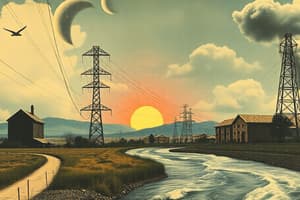Podcast
Questions and Answers
Which of the following statements best describes the indirect losses businesses may face due to climate-related extreme weather events?
Which of the following statements best describes the indirect losses businesses may face due to climate-related extreme weather events?
- They primarily impact property values of commercial real estate.
- They only affect companies located in disaster-prone areas.
- They directly increase insurance premiums for businesses.
- They can lead to productivity loss even if physical assets remain intact. (correct)
How do natural disasters typically affect households from underserved communities according to the impacts discussed?
How do natural disasters typically affect households from underserved communities according to the impacts discussed?
- They experience less disruption in daily life.
- They lead to increased wealth accumulation.
- They often face lower levels of insurance coverage. (correct)
- They benefit from rapid recovery programs.
What potential financial challenge may local governments face as a result of climate change?
What potential financial challenge may local governments face as a result of climate change?
- Increased revenues from tourist attractions.
- Exemption from usual financial regulations.
- A surplus of funding from federal grants.
- Budget deficits due to infrastructure destruction. (correct)
Which of the following is a consequence of property damage that poses risks on a larger economic scale?
Which of the following is a consequence of property damage that poses risks on a larger economic scale?
What form of financial accountability may not be adequately addressed by many institutions facing physical climate risk?
What form of financial accountability may not be adequately addressed by many institutions facing physical climate risk?
What significant financial burden was observed in local government budgets from 1990 to 2015 due to California wildfires?
What significant financial burden was observed in local government budgets from 1990 to 2015 due to California wildfires?
Which community is least likely to be resilient in the face of climate-induced challenges?
Which community is least likely to be resilient in the face of climate-induced challenges?
What is the primary reason insurance providers face challenges after natural disasters?
What is the primary reason insurance providers face challenges after natural disasters?
Which program provides the majority of flood insurance in the United States?
Which program provides the majority of flood insurance in the United States?
What is classified as transition risk in the context of climate change?
What is classified as transition risk in the context of climate change?
How can government actions influence transition risk?
How can government actions influence transition risk?
What consequence might businesses face during the shift to net-zero emissions?
What consequence might businesses face during the shift to net-zero emissions?
What factor could lead to underinvestment or overinvestment in business activities during the transition to decarbonization?
What factor could lead to underinvestment or overinvestment in business activities during the transition to decarbonization?
What is the primary characteristic of stranded assets?
What is the primary characteristic of stranded assets?
Which of the following risks are local governments particularly sensitive to?
Which of the following risks are local governments particularly sensitive to?
What significant challenge is highlighted regarding fossil fuel communities?
What significant challenge is highlighted regarding fossil fuel communities?
What is one potential implication for the financial sector as discussed?
What is one potential implication for the financial sector as discussed?
What is a critical need by 2050 that is highlighted in relation to climate finance?
What is a critical need by 2050 that is highlighted in relation to climate finance?
What type of risks are associated with both individual companies and the broader public system?
What type of risks are associated with both individual companies and the broader public system?
What factor might increase the cost of capital for borrowers after a natural disaster?
What factor might increase the cost of capital for borrowers after a natural disaster?
How do municipal debts affected by hurricanes typically respond to rating agencies?
How do municipal debts affected by hurricanes typically respond to rating agencies?
What is a characteristic of systemic risk in financial markets?
What is a characteristic of systemic risk in financial markets?
What is the relationship between firms with higher carbon emissions and investor demands?
What is the relationship between firms with higher carbon emissions and investor demands?
Which of the following best describes climate risk in financial markets?
Which of the following best describes climate risk in financial markets?
What risk exemplifies the cascading failures seen in financial markets like during the 2008 financial crisis?
What risk exemplifies the cascading failures seen in financial markets like during the 2008 financial crisis?
What is the implication of higher yields paid by municipalities exposed to sea level rise?
What is the implication of higher yields paid by municipalities exposed to sea level rise?
In financial contexts, what does systemic risk particularly involve?
In financial contexts, what does systemic risk particularly involve?
What is a primary reason climate risks are considered non-diversifiable?
What is a primary reason climate risks are considered non-diversifiable?
Which factor is NOT mentioned as being impacted by climate risks?
Which factor is NOT mentioned as being impacted by climate risks?
How might climate risks contribute to systemic financial crises according to the content?
How might climate risks contribute to systemic financial crises according to the content?
How do climate risks affect asset pricing in financial markets?
How do climate risks affect asset pricing in financial markets?
What is a possible consequence of significant updates in climate science?
What is a possible consequence of significant updates in climate science?
Which aspect of climate risks directly affects the general public?
Which aspect of climate risks directly affects the general public?
What does interconnectedness in climate risks refer to?
What does interconnectedness in climate risks refer to?
Why might prices of certain assets be particularly sensitive to climate events?
Why might prices of certain assets be particularly sensitive to climate events?
What is the primary focus of climate risk scenario analyses compared to traditional macroeconomic stress testing?
What is the primary focus of climate risk scenario analyses compared to traditional macroeconomic stress testing?
In what time frame do macroeconomic stress tests typically operate?
In what time frame do macroeconomic stress tests typically operate?
Which element is emphasized in traditional macroeconomic stress testing compared to climate-related scenario analysis?
Which element is emphasized in traditional macroeconomic stress testing compared to climate-related scenario analysis?
What distinguishes sensitivity analysis from other types of scenario analysis?
What distinguishes sensitivity analysis from other types of scenario analysis?
What is a key purpose of climate-related scenario analyses in financial institutions?
What is a key purpose of climate-related scenario analyses in financial institutions?
How do climate-related scenario analyses differ in scope compared to macroeconomic stress testing?
How do climate-related scenario analyses differ in scope compared to macroeconomic stress testing?
Which aspect is unique to climate-related risk that is not typically included in macroeconomic stress testing?
Which aspect is unique to climate-related risk that is not typically included in macroeconomic stress testing?
What is the primary regulatory purpose of macroeconomic stress testing?
What is the primary regulatory purpose of macroeconomic stress testing?
Flashcards
Climate Change Financial Risks
Climate Change Financial Risks
The potential financial consequences of climate change, such as insurance payouts or government spending.
Wildfire Costs for Governments
Wildfire Costs for Governments
The increase in government spending caused by natural disasters, specifically in this case, wildfires. This can strain local budgets.
Insurance Risk from Climate Change
Insurance Risk from Climate Change
The risk that traditional insurance models become inadequate due to increased frequency and severity of natural disasters.
Transition Risk
Transition Risk
Signup and view all the flashcards
Government Policy and Transition Risk
Government Policy and Transition Risk
Signup and view all the flashcards
Investment Uncertainty and Transition Risk
Investment Uncertainty and Transition Risk
Signup and view all the flashcards
Transition Risk for High-Emission Businesses
Transition Risk for High-Emission Businesses
Signup and view all the flashcards
Insurance Unaffordability
Insurance Unaffordability
Signup and view all the flashcards
Baked-in Physical Risks
Baked-in Physical Risks
Signup and view all the flashcards
Physical Risks for Businesses
Physical Risks for Businesses
Signup and view all the flashcards
Physical Risks for Households
Physical Risks for Households
Signup and view all the flashcards
Climate Change and Financial Instability
Climate Change and Financial Instability
Signup and view all the flashcards
Physical Risks for Local Governments
Physical Risks for Local Governments
Signup and view all the flashcards
Climate Change and Budget Deficits
Climate Change and Budget Deficits
Signup and view all the flashcards
Physical Damage and Reconstruction
Physical Damage and Reconstruction
Signup and view all the flashcards
Budget Allocation and Strain
Budget Allocation and Strain
Signup and view all the flashcards
Stranded Assets
Stranded Assets
Signup and view all the flashcards
Stranded Asset Example
Stranded Asset Example
Signup and view all the flashcards
Transition Risk for Governments
Transition Risk for Governments
Signup and view all the flashcards
Climate Finance Implications
Climate Finance Implications
Signup and view all the flashcards
Climate Finance
Climate Finance
Signup and view all the flashcards
Investment Needs
Investment Needs
Signup and view all the flashcards
Climate Finance Importance
Climate Finance Importance
Signup and view all the flashcards
Climate Risk as Systemic Risk
Climate Risk as Systemic Risk
Signup and view all the flashcards
Interconnectedness of Climate Risks
Interconnectedness of Climate Risks
Signup and view all the flashcards
Market-wide Impacts of Climate Change
Market-wide Impacts of Climate Change
Signup and view all the flashcards
Climate Change and Financial Crises
Climate Change and Financial Crises
Signup and view all the flashcards
Uncertainty in Climate Risk Assessment
Uncertainty in Climate Risk Assessment
Signup and view all the flashcards
Price Sensitivity to Climate Factors
Price Sensitivity to Climate Factors
Signup and view all the flashcards
Climate Risks and Retirement Savings
Climate Risks and Retirement Savings
Signup and view all the flashcards
Climate Change and Investment Timeframes
Climate Change and Investment Timeframes
Signup and view all the flashcards
Higher Cost of Capital Due to Climate Risk
Higher Cost of Capital Due to Climate Risk
Signup and view all the flashcards
Climate Risk Impact on Municipal Debt Ratings
Climate Risk Impact on Municipal Debt Ratings
Signup and view all the flashcards
Impact of Carbon Emissions on Stock Prices
Impact of Carbon Emissions on Stock Prices
Signup and view all the flashcards
Climate Risk: A Systemic Threat
Climate Risk: A Systemic Threat
Signup and view all the flashcards
Climate Risk: Similar to 2008 Financial Crisis
Climate Risk: Similar to 2008 Financial Crisis
Signup and view all the flashcards
Climate Impact on Financial Stability
Climate Impact on Financial Stability
Signup and view all the flashcards
What is climate scenario analysis?
What is climate scenario analysis?
Signup and view all the flashcards
How is climate scenario analysis different from macroeconomic stress testing?
How is climate scenario analysis different from macroeconomic stress testing?
Signup and view all the flashcards
What is sensitivity analysis?
What is sensitivity analysis?
Signup and view all the flashcards
How is sensitivity analysis applied in climate finance?
How is sensitivity analysis applied in climate finance?
Signup and view all the flashcards
What is the primary purpose of climate scenario analysis?
What is the primary purpose of climate scenario analysis?
Signup and view all the flashcards
How is climate scenario analysis utilized in practice?
How is climate scenario analysis utilized in practice?
Signup and view all the flashcards
What are the practical benefits of climate scenario analysis for financial institutions?
What are the practical benefits of climate scenario analysis for financial institutions?
Signup and view all the flashcards
How can climate scenario analysis be used to understand climate change's impact on finance?
How can climate scenario analysis be used to understand climate change's impact on finance?
Signup and view all the flashcards
Study Notes
Lecture 1: Climate Finance - Framing the Problem
- Lecture 1, Climate Finance, Framing the problem, was presented by Prof João Amaro de Matos at Ca' Foscari University of Venice on April 8th, 2024.
Agenda
- Evidence
- Why does it matter for finance
- Types of financial risks associated with climate change
- Physical risk
- Transition risk
- Implications for financial sector and the public
- Cost of capital
- Systemic risk and stability of the financial system
- Burden on the public
- Ways to assess and manage climate financial risk
- Disclosure
- Risk Management
- Climate Stress Testing
Some Evidence
- Global average temperature change from 1850-2020 is presented in a graphic.
Economic Growth, Innovation, and Welfare
- Historical data on GDP per capita for various countries is shown in a graph.
- Another graph shows a recent trend for hours of work needed to produce 1000 lumen hours.
- The graphs show long-term economic activity and its association with global developments across different periods.
Global Average Temperature Change
- Graph illustrating the global average temperature change from approximately 1,800 to 2000 showing significant change in recent decades.
- The graph also shows CO2 levels over time, suggesting that CO2 levels are higher than any time in the past 800,000 years.
Anthropogenic GHG Emissions and CC
- A graph charts annual human CO2 emissions (Mt/yr) up to 2000.
- A second graph shows observed vs. simulated global warming patterns correlated with the amount of anthropogenic GHG emissions.
Why does it matter for finance?
- Investors seek returns greater than initial investment.
- Financial losses can occur if the venture underperforms or fails.
- Risk-return trade-offs are central to investment decisions and drive demand for higher returns with higher risk.
- Climate change impacts are widespread.
- Actions to reduce emissions affect financial risks.
- Understanding and managing these risks are crucial to stability.
Types of Risk
- Physical Risks are risks associated with events (earthquakes, floods, wildfires, etc.) that damage assets and infrastructure.
- Transition Risks are risks associated with the uncertain path to a decarbonized economy, including regulation and shifts in consumer demands and investment.
Physical Risks: Impacts
- Businesses face climate change-related physical risks, even when assets are not damaged.
- These risks include disruptions to supply chains, agricultural loss, increased vulnerabilities for households, and a significant increase in the burden on local governments.
- Examples of losses from natural disasters like the 2018 California wildfires show a substantial portion of indirect losses from disrupted economic activity.
Transition Risk
- Limiting further climate change necessitates significant alterations. This involves large-scale shifts in the global economy.
- Transition risks stem from the uncertain path to a decarbonized economy.
- Transition risk is influenced by government policies and investor projections.
Transition Risk: Impacts
- Businesses can suffer significant losses when relying on greenhouse gas-intensive raw materials/processes.
- Stranded assets are durable assets becoming unusable or prematurely decommissioned due to changing policies or markets.
- Local governments, relying on industries like oil and gas for revenue, can experience significant impacts from the shift away from fossil fuels.
Broad Risk Measurement Approaches
- Different methods exist to assess and measure climate risk, ranging from scenario analyses and stress testing to climate sensitivity analysis and climate value at risk metrics.
Stress Testing
- Stress testing is a specific subset of scenario analysis. This particular subset of scenario analysis is utilized to assess and evaluate the resilience of financial institutions' near-term, financial systems' resilience in response to economic shocks.
- There are two types of macro-prudential and micro-prudential stress tests.
Implications
- The impacts of climate risks range from profit losses and higher default risks for individual companies and investors to broader concerns regarding financial system stability and public burdens.
- Recent climate-related impacts, notably those resulting from weather-related events, have begun to affect the cost of capital for entities like municipalities and corporations.
Studying That Suits You
Use AI to generate personalized quizzes and flashcards to suit your learning preferences.




